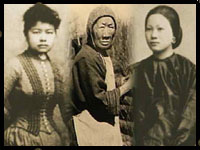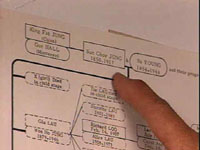 |
Viewer Guide: Part 2
This second episode of the series Ancestors in the Americas chronicles the arrival and experiences of Chinese immigrants on the West Coast of the United States during the 1850's Gold Rush. The indispensable contributions of Chinese laborers in building the new frontier, the well-developed communities created by the Chinese in the face of heavy restrictions and discrimination, and the importance of Chinese legal activism in broadening American laws and establishing precedents guaranteeing all people their civil rights is revealed in this program. Chinese in the Frontier West: An American Story interweaves archival images and footage of archeological sites across the West with poetic imagery and a first-person perspective to evoke the human faces and spirit of history. Scholars Sucheng Chan, Gary Okihiro, Patricia Limerick, Judy Yung, Ling-chi Wang, and Roger Daniels guide us through this rich, complex, buried history. A sophisticated and critical retelling of history, Chinese in the Frontier West portrays a community responding to the challenge posed by its distinctive position in America, with far-reaching consequences for all that followed. This Viewer Guide offers a variety of approaches to working with a wide range of issues raised by the film. It draws heavily on the video and primary source materials reproduced from it. II. CENTRAL QUESTIONS This program asserts that the Chinese American story is quintessential American history, and at same time the story offers another lens, another perspective for examining America itself. What in the story makes it quintessentially American? What do we learn about America from looking at this Asian American experience? 1. Why were the Chinese invisible, not found in the stories told, although their presence was pervasive and economically pivotal?(e.g., not found in celebratory picture of completion of Transcontinental Railroad; not found in pictures of workers in archives) 2. Whose history is this? Is it only ethnic history? Is it only Chinese American history? Is it of relevance to other Asian Americans, other persons of color, other Americans? How? If the film makes a key assertion that claims it is telling an "American story", what is the evidence, and what is the argument for this? 3. Are Asian American immigrants "just like other immigrants"? Are they like the more familiar ones from European countries- following the pattern of initial hardship and discrimination, hard work, patience mobility, and after a generation or two, success and integration into the society at large. If Asian American immigrants are different, in what ways are they different? Can the record which recounts their contributions to the development of the California economy be considered an early example of Chinese as a "model minority"? 4. Is it true that Chinese Americans did not assimilate? Is it a main cause of their troubles? (e.g., building temples, eating Chinese food, sending bones home... ) Would they have suffered less discrimination and exclusion, if they had assimilated more, made themselves more acceptable by American norms of dress, behavior, and ideas. (e.g. cut queue, wear western clothes, attend church,etc.) 5. In terms of identity politics, is claiming "Chinese in the frontier West" as an American experience psychologically equivalent to seeking the "acceptance "of Anglo Americans? Does it cede others the power and authority to define who is /who is not American? i.e., Is framing Chinese American experiences as "American" the same as mainstreaming yourself, rather than taking a critical stance and interrogating the "mainstream"? In this approach what is the "center" and where is the "margin"? 6. What strategies of representation are involved in telling this story? The primary question to be answered is from whose viewpoint is this story told? The primary strategy of representation running through the whole film is to consistently construct and seek to give credible voice to the perspective and interests of the presumed Chinese characters: the attitude and words of the time traveler narrator, some ordinary worker, a woman of the period, etc. The purpose is to make visible and compelling the presence and attitude of the Chinese laborer and Chinese women of that time and place. All of whose thoughts, feelings, words are missing from the historical records. 7. What strategies of narrative (story telling) are employed? This film uses a "documemoir" approach as a narrative strategy which combines dramatic reenactments and fictive or composite voices with more standard historiographic means such as institutional records, newspaper, immigration dept. archives, archeological artifacts, etc. Are there problems in mixing "facts" with "fiction" in this way? Is this a case of where filmmaking and media purposes part from historiographic purposes? Who is the film for? Where do the interests of the viewer fit in this equation? Who adjudicates? III. GUIDE CONTENTS A. Previewing Discussion: Examining Assumptions B. Post-viewing Discussion: Reviewing Assumptions and Exploring Quotes C. Exploring Video Themes
D. Click here to view the Glossary. A. PREVIEWING DISCUSSION: EXAMINING ASSUMPTIONS What images come to your mind when you think of people who settled the frontier west? What did they look like? What did they wear? Where did they come from? By what routes did they arrive in the west? What are the sources of your images and ideas (Films, textbooks, etc.)? How many racial and ethnic groups came to mind when thinking about this question? B. POST-VIEWING DISCUSSION: RECONSIDERING ASSUMPTIONS AND EXPLORING QUOTES What images can you now add to your previous ones of peoples who settled America's western frontier? This film uses interviews, narratives, and folk sayings to tell its story. Relate these statements to what you have learned in the film. Folk Sayings: "Beware you will have only an old cooking pot to keep you warm." "When you drink water you should remember the source." "The fallen leaf returns to its roots." "The foot set down grows new roots." Narrator's and scholars' comments: "Why can't I find photo of a Chinese worker?" "What is history when the reporter doesn't record, and the camera doesn't see?" "We left our village, but our village never left us." "After we stand in cold water all day, we are not too tired to build this temple." "Chinese labor was the only game in town." "It's not until the Chinese came...that people start eating in a way that stopped them from being sick most of the time." "I don't say women were prostitutes, they were women who were impressed into prostitution." "What if it had been possible for the Chinese communities to have families?" "We had our first sit-in in California...where Chinese said...enough...and stood their ground." "We basically extended the promise of the American dream to a wider range of human beings than the founding fathers." C. EXPLORING VIEWING THEMES
II. WHO WILL HAVE THE RIGHTS OF AMERICANS?
"The 10,000 dollar haircut."
III. WHAT IF IT HAD BEEN DIFFERENT? CHINESE FAMILES:
Point Alones family, Monterey, CA
All male communities
Family tree of Maggie Gee
GENDER IMBALANCE CHART
Do you have a personal story to illustrate these examples? IV. ECONOMIC NICHES 1. Contributions to the Land Between 1860 -1890, Chinese workers were primarily responsible for the development of California's agriculture. In 1870, three fourths of California's agricultural workers were Chinese. Based on the following comments and images, discuss the lasting agricultural contributions of the Chinese. "It's not until the Chinese came....that people starting eating in a way that stopped them from being sick most of the time."
"The fruits and vegetable, raspberries and strawberries, under the care of Chinese gardeners grow to a fabulous size...I have seen heads of cabbages four times the size of European heads, and pumpkins the size of our washtubs". 2. Lasting Imprint on the Land The Chinese brought to America their communal approach to accomplishing tasks. Note how it served the Chinese in their work in building the railroads, agriculture, and mining. 3. Changing Patterns of Work in Industry By the 1870s the Chinese could be considered the first industrial workforce in the American West. In San Francisco, for example, the cigar industry employed more Chinese than any other ethnic group. In 1873, one half of all California's leather goods were 'made by Chinese workers'. By the 1880s, the Chinese themselves owned some of the firms. In the following chart, however, note the declining numbers of Chinese employed in cigar and shoe/boot industries. Percentages of Chinese Mainly in San Francisco Cigar and Shoe/Boot Industries
Consider this quote: "Seven decades of rapid economic change, anti-Chinese discrimination, and finally Chinese exclusion - rather than any inherent racial or cultural characteristics - had made the Chinese in the United States into an urban mercantile and servile population by the early twentieth century." How might the following national events have contributed to this changing pattern of work? 1861: The Civil War 1869: Completion of the transcontinental railroad. 1876: National economic depression. 1882: Exclusion Acts 1880-90s: Anti-Chinese riots, white boycotts of Chinese goods. 4. A Contemporary Look: Search the media for reports on the economic niches filled by immigrants today. Compare their survival strategies, receptivity of the larger society to their work, and their economic contributions with those from the program. home | about cet | about Loni Ding | cet productions ancestors | guides | documents | discover ancestors Copyright 1998-2009. Center for Educational Telecommunications, Inc. All Rights Reserved.
|

 3. China Mary was a generic name given to Chinese women. The lives of the three women in the film all named "China Mary" show that each led unique and individual lives. Reviewing the lives described of Mary Moulton of Oakdale California, Ah Yuen of Wyoming and Mary Bong of Sitka Alaska, rewrite the epithet on their gravestones.
3. China Mary was a generic name given to Chinese women. The lives of the three women in the film all named "China Mary" show that each led unique and individual lives. Reviewing the lives described of Mary Moulton of Oakdale California, Ah Yuen of Wyoming and Mary Bong of Sitka Alaska, rewrite the epithet on their gravestones.  4. Phrenology, a nineteenth century pseudoscience, claimed that the shape of an individual's skull could define his/her character and mental ability. Such theories were used to support the idea of racial hierarchy and racial superiority/inferiority. This belief made it easier to label those who weren’t considered "Americans" as "the other," or as aliens. How might the sense of being an "other" in America impact the perception of an immigrant as a perpetual foreigner/sojourner rather than a "settler" at "home in America"?
4. Phrenology, a nineteenth century pseudoscience, claimed that the shape of an individual's skull could define his/her character and mental ability. Such theories were used to support the idea of racial hierarchy and racial superiority/inferiority. This belief made it easier to label those who weren’t considered "Americans" as "the other," or as aliens. How might the sense of being an "other" in America impact the perception of an immigrant as a perpetual foreigner/sojourner rather than a "settler" at "home in America"?

